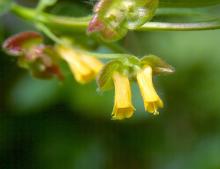Lonicera involucrata
Common name:
Twinberry
Black Twinberry
Inkberry
Pronunciation:
lon-ISS-er-a in-vo-lu-KRA-ta
Family:
Caprifoliaceae
Genus:
Type:
Broadleaf
Native to (or naturalized in) Oregon:
Yes
- Broadleaf deciduous shrub, 18 inches to 13 ft (0.5-4 m) tall, spreading, erect. Young stems are squarish in cross section. Leaves simple, opposite, 3-14 cm long, oblong, ovate or rarely obovate, often asymmetrical at base or tapering to the petioles, generally pubescent below and cilate on the margins. Flowers yellow and tinged with red, about 13 mm long, in pairs, sessile, between broad, pubescent bracts which eventually become reddish. Fruit paired, dark purple or black berries, about 5 mm wide.
- Sun to partial shade. Does well in wet or moist situations, but adapts to drier sites.
- Hardy to USDA Zone 4 Native range from Alaska to the southwest, eastward to the Lake States and Quebec. Hitchcock and Cronquist (1973) recognize two forms in the Pacific Northwest, with L. i. var. involucrata in the mountains and L. i. var. ledebourii coastal.
- involucrata: circle or collection of bracts, a reference to the two bracts subtending the pair of flowers/fruits.









